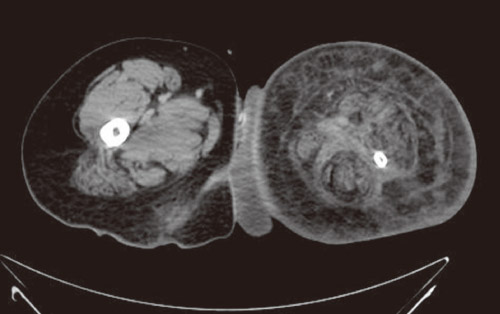Infect Chemother.
2010 Jun;42(3):187-189. 10.3947/ic.2010.42.3.187.
A Case of Group G Streptococcal Toxic Shock Syndrome
- Affiliations
-
- 1Department of Internal Medicine, Seoul National University College of Medicine, Seoul, Korea. molder@unitel.co.kr
- KMID: 2170308
- DOI: http://doi.org/10.3947/ic.2010.42.3.187
Abstract
- Toxic shock syndrome is an acute, multi-systemic, toxin-mediated illness caused by toxin-producing strains of Staphylococcus aureus and Streptococcus species. Streptococcal toxic shock syndrome is usually caused by Streptococcus pyogenes but Group G streptococcal toxic shock syndrome is rare. Herein, we report a case of group G streptococcal toxic shock syndrome that was successfully treated with toxin reducing antibiotics and intravenous immunoglobulin therapies.
Keyword
MeSH Terms
Figure
Cited by 2 articles
-
Two Cases of Streptococcal Toxic Shock Syndrome Caused by Streptococcus agalactiae and Streptococcus dysagalactiae
Young Sun Suh, Yun-Hong Cheon, Min Kyo Kim, Jong-Hwa Ahn, Sang Su Lee, Min Hee Lim, Byung Hoon Kim, Sunjoo Kim, Myung-Je Cho, In-Gyu Bae
Infect Chemother. 2011;43(5):429-431. doi: 10.3947/ic.2011.43.5.429.Group B Streptococcal Toxic Shock-like Syndrome: A Case Report and Review of the Literature
Bo Ra Son, Kyeong Seob Shin
Ann Clin Microbiol. 2014;17(3):91-94. doi: 10.5145/ACM.2014.17.3.91.
Reference
-
1. Lappin E, Ferguson AJ. Gram-positive toxic shock syndromes. Lancet Infect Dis. 2009. 9:281–290.
Article2. Stevens DL. The toxic shock syndromes. Infect Dis Clin North Am. 1996. 10:727–746.
Article3. Cone LA, Woodard DR, Schlievert PM, Tomory GS. Clinical and bacteriologic observations of a toxic shock-like syndrome due to Streptococcus pyogenes. N Engl J Med. 1987. 317:146–149.
Article4. Bisno AL, Stevens DL. Mandell GL, Bennett JE, Dolin R, editors. Streptococcus pyogenes. Priniciples and practice of Infectious diseases. 2005. 6th ed. Philadelphia: Elsevier Inc.;2373.
Article5. Wagner JG, Schlievert PM, Assimacopoulos AP, Stoehr JA, Carson PJ, Komadina K. Acute group G streptococcal myositis associated with streptococcal toxic shock syndrome: case report and review. Clin Infect Dis. 1996. 23:1159–1161.
Article6. Kugi M, Tojo H, Haraga I, Takata T, Handa K, Tanaka K. Toxic shock-like syndrome caused by group G Streptococcus. J Infect. 1998. 37:308–309.
Article7. Horii T, Izumida S, Takeuchi K, Tada T, Ishikawa J, Tsuboi K. Acute peritonitis and salpingitis associated with streptococcal toxic shock syndrome caused by Lancefield group G alpha-haemolytic Streptococcus dysgalactiae subsp. equisimilis. J Med Microbiol. 2006. 55:953–956.
Article8. The Working Group on Severe Streptococcal Infections. Defining the group A streptococcal toxic shock syndrome: rationale and consensus definition. JAMA. 1993. 269:390–391.9. Sendi P, Johansson L, Norrby-Teglund A. Invasive group B Streptococcal disease in non-pregnant adults: a review with emphasis on skin and soft-tissue infections. Infection. 2008. 36:100–111.
Article10. Hashikawa S, Iinuma Y, Furushita M, Ohkura T, Nada T, Torii K, Hasegawa T, Ohta M. Characterization of group C and G streptococcal strains that cause streptococcal toxic shock syndrome. J Clin Microbiol. 2004. 42:186–192.
Article11. Cunningham MW. Pathogenesis of group A streptococcal infections. Clin Microbiol Rev. 2000. 13:470–511.
Article12. Tan JS, File TM. Yu VL, Weber R, Raoult D, editors. Streptococcus species. Antimicrobial therapy and vaccines. 2002. 2nd ed. New York: Apple tree productions, LLC;736.13. Zimbelman J, Palmer A, Todd J. Improved outcome of clindamycin compared with beta-lactam antibiotic treatment for invasive Streptococcus pyogenes infection. Pediatr Infect Dis J. 1999. 18:1096–1100.
Article14. Mascini EM, Jansze M, Schouls LM, Verhoef J, Van Dijk H. Penicillin and clindamycin differentially inhibit the production of pyrogenic exotoxins A and B by group A streptococci. Int J Antimicrob Agents. 2001. 18:395–398.
Article15. Norrby-Teglund A, Stevens DL. Novel therapies in streptococcal toxic shock syndrome: attenuation of virulence factor expression and modulation of the host response. Curr Opin Infect Dis. 1998. 11:285–291.16. Darenberg J, Ihendyane N, Sjölin J, Aufwerber E, Haidl S, Follin P, Andersson J, Norrby-Teglund A. StreptIg Study Group. Intravenous immunoglobulin G therapy in streptococcal toxic shock syndrome: a European randomized, double-blind, placebo-controlled trial. Clin Infect Dis. 2003. 37:333–340.
Article
- Full Text Links
- Actions
-
Cited
- CITED
-
- Close
- Share
- Similar articles
-
- A Case of Streptococcal Toxic Shock Like Syndrome with Pleural Effusion
- Group B Streptococcal Toxic Shock-like Syndrome: A Case Report and Review of the Literature
- The Case of Streptococcal Toxic Shock-like Syndrome
- A Case of Streptococcal Toxic Shock Syndrome Caused by Group A Streptococcus Pneumonia
- Streptococcal Toxic Shock Syndrome Associated with Intrauterine Fetal Death: A Case Report


